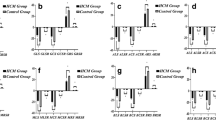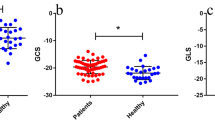Abstract
The evaluation of cardiac magnetic resonance feature tracking may have great diagnostic value in hypertrophic cardiomyopathy and hypertensive heart disease. Exploring the diagnostic and clinical research value of cardiac magnetic resonance feature tracks in evaluation of myocardium deformation in patients with subclinical hypertrophic cardiomyopathy(SHCM)and subclinical hypertensive heart disease(SHHD). Cardiovascular Magnetic Resonance (CMR) scans were performed on a 1.5 T MR scanner in 33 patients with SHCM, 31 patients with SHHD, and 27 controls(NS). The CMR image post-processing software was used to analyze the characteristics of routine cardiac function, different global and regional myocardial strain in each group. Analysis of variance (ANOVA) was used to compare age, blood pressure, heart rate, routine cardiac function, body mass index (BMI), as well as the strain between different segments within each of the three groups. Once a significant difference was detected, a least significant difference (LSD) comparison would be performed. The diagnostic efficacy of different parameters in differentiating SHHD from SHCM was evaluated through receiver operating characteristic (ROC) curve analysis, and the best cut-off value was determined. There was no statistical difference among three groups (P>0.05) in routine cardiac function while significant statistical differences were found in the global myocardial strain parameters and the peak strain parameters of some segments (especially basal segments) (P < 0.05). The global radial peak strain (GRPS) was most effective (AUC = 0.885, 95% CI: 0.085–0.971, P<0.001) with a sensitivity and specificity of 84% and 88% at a cut-off value of 40.105, contributing to distinguishing SHCM from SHHD group. Cardiac magnetic resonance feature tracking could detect left ventricular deformation in patients with SHCM and SHHD group. The abnormality of strain has important research value for subclinical diagnosis and clinical evaluation.




Similar content being viewed by others
References
George J, James CM, Luis RL (2023) Detection of subclinical hypertrophic cardiomyopathy.Nat Rev Cardiol. 2023;20(6):369–370. doi:https://doi.org/10.1038/s41569-023-00853-7
Efthimiadis GK, Pagourelias ED, Hadjimiltiades S, Meditskou S, Karvounis H, McKenna WJ (2015) Feasibility and significance of preclinical diagnosis in hypertrophic cardiomyopathy. Cardiol Rev. 2015 Nov-Dec;23(6):297–302. doi: https://doi.org/10.1097/CRD.0000000000000076
Vigneault DM, Yang E, Jensen PJ, Tee MW, Farhad H, Chu L, Noble JA, Day SM, Colan SD, Russell MW, Towbin J, Sherrid MV, Canter CE, Shi L, Ho CY, Bluemke DA (2019) Left ventricular strain is abnormal in preclinical and overt hypertrophic cardiomyopathy: Cardiac MR Feature Tracking. Radiology 290(3):640–648. https://doi.org/10.1148/radiol.2018180339Epub 2018 Dec 18. PMID: 30561279; PMCID: PMC6394738
Captur G, Lopes LR, Mohun TJ, Patel V, Li C, Bassett P, Finocchiaro G, Ferreira VM, Esteban MT, Muthurangu V, Sherrid MV, Day SM, Canter CE, McKenna WJ, Seidman CE, Bluemke DA, Elliott PM, Ho CY, Moon JC (2014) Prediction of sarcomere mutations in subclinical hypertrophic cardiomyopathy. Circ Cardiovasc Imaging 7(6):863–871 Epub 2014 Sep 16. PMID: 25228707; PMCID: PMC4237712
Twiner MJ, Marinica AL, Kuper K, Goodman A, Mahn JJ, Burla MJ, Brody AM, Carroll JA, Josiah Willock R, Flack JM, Nasser SA, Levy PD (2017) Screening and treatment for subclinical Hypertensive Heart Disease in Emergency Department patients with uncontrolled blood pressure: a cost-effectiveness analysis. Acad Emerg Med 24(2):168–176. https://doi.org/10.1111/acem.13122. Epub 2017 Jan 30. Erratum in: Acad Emerg Med. 2020;27(4):351. PMID: 27797437; PMCID: PMC5438204
Levy P, Ye H, Compton S, Zalenski R, Byrnes T, Flack JM, Welch R (2012) Subclinical hypertensive heart disease in black patients with elevated blood pressure in an inner-city emergency department. Ann Emerg Med 60(4):467–74e1. https://doi.org/10.1016/j.annemergmed.2012.03.030. Epub 2012 May 31. Erratum in: Ann Emerg Med. 2013;61(1):61. PMID: 22658278
Milan A, Puglisi E, Magnino C, Naso D, Abram S, Avenatti E, Rabbia F, Mulatero P, Veglio F (2012) Left atrial enlargement in essential hypertension: role in the assessment of subclinical hypertensive heart disease. Blood Press 21(2):88–96 Epub 2011 Oct 13. PMID: 21992014
Prendergast HM, Colla J, Patel N, Del Rios M, Marcucci J, Scholz R, Ngwang P, Cappitelli K, Daviglus M, Dudley S (2015) Correlation between Subclinical Heart Disease and Cardiovascular Risk Profiles in an urban Emergency Department Population with elevated blood pressures: a pilot study. J Emerg Med 48(6):756–761 Epub 2015 Mar 20. PMID: 25802165; PMCID: PMC4457673
Olivotto I, Maron MS, Rega L, Casolo G et al (2008) Assessment and significance of left ventricular mass by cardiovascular magnetic resonance in hypertrophic cardiomyopathy. J Am Coll Cardiol 52:559–566. https://doi.org/10.1016/j.jacc.2008.04.047
Augustine D, Lewandowski A, J,Lazdam M, Rai A, Francis J, Myerson S et al (2013) Global and regional left ventricular myocardial deformation measures by magnetic resonance feature tracking in healthy volunteers: comparison with tagging and relevance of gender. J Cardiovasc Magn Reson 15:8. https://doi.org/10.1186/1532-429X-15-8
Zerhouni EA, Rogers WJ, Yang A, Shapiro EP .(1988)human heart: tagging with MR imaging–a method for noninvasive assessment of Myocard motion Radiol 169:59–63doi: https://doi.org/10.1148/radiology.169.1.3420283
Hor KN, Baumann R, Pedrizzetti G, Tonti G, Gottliebson WM et al (2011) Magnetic resonance derived myocardial strain assessment using feature tracking. J Vis Exp 12:2356. https://doi.org/10.3791/2356
Rahman ZU, Sethi P, Murtaza G, Virk HUH, Rai A, Mahmod M et al (2017) Feature tracking cardiac magnetic resonance imaging: a review of a novel non-invasive cardiac imaging technique. World J Cardiol 9:312–319. https://doi.org/10.4330/wjc.v9.i4.312
Kuetting DLR, Homsi R, Sprinkart AM, Luetkens J, Thomas DK, Schild HH et al (2017) Quantitative assessment of systolic and diastolic function in patients with LGE negative systemic amyloidosis using CMR. Int J Cardiol 232:336–341. https://doi.org/10.1016/j.ijcard.2016.12.054
Schuster A, Hor KN, Kowallick JT, Kutty S (2016) Cardiovascular magnetic resonance myocardial feature tracking: concepts and clinical applications. Circ Cardiovasc Imaging 9:e004077. https://doi.org/10.1161/CIRCIMAGING.115.004077
Wu L, Germans T, Güçlü A, Heymans MW, Allaart CP, Rossum AC (2014) Feature tracking compared with tissue tagging measurements of segmental strain by cardiovascular magnetic resonance. J Cardiovasc Magn Reson 16:10. https://doi.org/10.1186/1532-429X-16-10
Hor KN, Gottliebson WM, Carson C, Wash E, Cnota J, Fleck R et al (2010) Comparison of magnetic resonance feature tracking for strain calculation with harmonic phase imaging analysis. JACC Cardiovasc Imaging 3:144–151. https://doi.org/10.1016/j.jcmg.2009.11.006
Ibrahim el-S.H (2011) Myocardial tagging by cardiovascular magnetic resonance: evolution of techniques–pulse sequences, analysis algorithms, and applications. J Cardiovasc Magn Reson 13:36. https://doi.org/10.1186/1532-429X-13-36
Schuster A, Morton G, Hussain ST, Kutty S, Asrress KN et al The intra-observer reproducibility of cardiovascular magnetic resonance myocardial feature tracking strain assessment is independent of field strength.Eur J Radiol 82:296–301doi: https://doi.org/10.1016/j.ejrad.2012.11.012
Claus P, Omar AMS, Pedrizzetti G, Sengupta PP (2015) Tissue Tracking Technology for assessing Cardiac mechanics: principles, normal values, and clinical applications. JACC Cardiovasc Imaging 8:1444–1460. https://doi.org/10.1016/j.jcmg.2015.11.001
Nucifora G, Muser D, Gianfagna P, Morocutti G, Proclemer A (2015) Systolic and diastolic myocardial mechanics in hypertrophic cardiomyopathy and their link to the extent of hypertrophy, replacement fibrosis and interstitial fibrosis. Int J Cardiovasc Imaging 31:1603–1610. https://doi.org/10.1007/s10554-015-0720-0. Epub 2015 Jul 26
Sen-Chowdhry S, Jacoby D, Moon JC (2016) Update on hypertrophic cardiomyopathy and a guide to the guidelines. Nat Rev Cardiol 13:651–675. https://doi.org/10.1038/nrcardio.2016.140.Epub 2016 Sep 29
Gersh BJ, Maron BJ et al (2011) ),.2011 ACCF/AHA guideline for the diagnosis and treatment of hypertrophic cardiomyopathy: executive summary: a report of the American College of Cardiology Foundation/American Heart Association Task Force on Practice Guidelines. Circulation 124:2761–2796. https://doi.org/10.1161/CIR.0b013e318223e230Epub 2011 Nov 8
Smiseth OA, Torp H, Opdahl A, Haugaa KH, Urheim S (2016) Myocardial strain imaging: how useful is it in clinical decision making? Eur Heart J 37:1196–1207. https://doi.org/10.1093/eurheartj/ehv529Epub 2015 Oct 27
Taylor RJ, Umar F, Moody WE, Stegemann B, Townend JN et al (2014) Feature-tracking cardiovascular magnetic resonance as a novel technique for the assessment of mechanical dyssynchrony. Int J Cardiol 175:120–125. https://doi.org/10.1016/j.ijcard.2014.04.268.Epub 2014 May 9
Smith BM, Dorfman AL, Russell MW, Mahani MG et al (2014) Relation of strain by feature tracking and clinical outcome in children, adolescents, and young adults with hypertrophic cardiomyopathy. Am J Cardiol 114:1275–1280 .Epub 2014 Jul 30
Acknowledgements
We especially thank Dr. Haonan Guan from GE Healthcare for help in solving MR technical problems.
Author information
Authors and Affiliations
Corresponding author
Additional information
Publisher’s Note
Springer Nature remains neutral with regard to jurisdictional claims in published maps and institutional affiliations.
Rights and permissions
Springer Nature or its licensor (e.g. a society or other partner) holds exclusive rights to this article under a publishing agreement with the author(s) or other rightsholder(s); author self-archiving of the accepted manuscript version of this article is solely governed by the terms of such publishing agreement and applicable law.
About this article
Cite this article
Hao, X., Wu, J., Zhu, L. et al. Evaluation of myocardial strain in patients with subclinical hypertrophic cardiomyopathy and subclinical Hypertensive Heart Disease using Cardiac magnetic resonance feature tracking. Int J Cardiovasc Imaging 39, 2237–2246 (2023). https://doi.org/10.1007/s10554-023-02930-x
Received:
Accepted:
Published:
Issue Date:
DOI: https://doi.org/10.1007/s10554-023-02930-x




